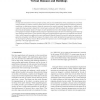94 search results - page 10 / 19 » Impact of Dynamic Model Learning on Classification of Human ... |
IJCAI
2007
13 years 9 months ago
2007
Programming a humanoid robot to walk is a challenging problem in robotics. Traditional approaches rely heavily on prior knowledge of the robot's physical parameters to devise...
ICIP
2007
IEEE
14 years 9 months ago
2007
IEEE
Tracking 3D people from monocular video is often poorly constrained. To mitigate this problem, prior knowledge should be exploited. In this paper, the Gaussian process spatio-temp...
CGF
2005
13 years 7 months ago
2005
In large-scale simulations involving complex scenes, such as cities inhabited by crowds, simplifications are almost always necessary to achieve interactive frame-rates. Level of D...
CVPR
2004
IEEE
14 years 9 months ago
2004
IEEE
Model-based clustering of motion trajectories can be posed as the problem of learning an underlying mixture density function whose components correspond to motion classes with dif...
PAMI
2010
13 years 6 months ago
2010
—Facial expression is a natural and powerful means of human communication. Recognizing spontaneous facial actions, however, is very challenging due to subtle facial deformation, ...

